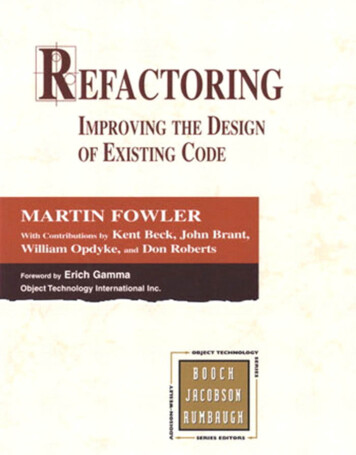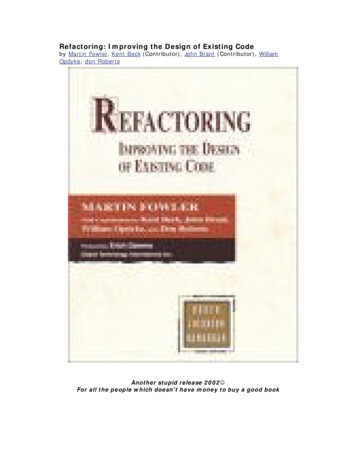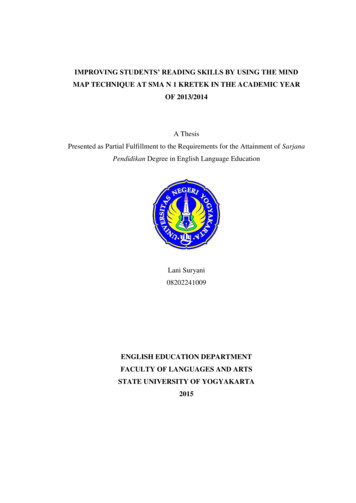
Transcription
Refactoring
The Addison-Wesley Object Technology SeriesGrady Booch, Ivar Jacobson, and James Rumbaugh, Series EditorsFor more information, check out the series web site at www.awprofessional.com/otseries.Ahmed/Umrysh, Developing Enterprise Java Applications with J2EE and UMLArlow/Neustadt, Enterprise Patterns and MDA: Building Better Softwarewith Archetype Patterns and UMLArlow/Neustadt, UML 2 and the Unified Process, Second EditionArmour/Miller, Advanced Use Case Modeling: Software SystemsBellin/Simone, The CRC Card BookBergström/Råberg, Adopting the Rational Unified Process: Success withthe RUPBinder, Testing Object-Oriented Systems: Models, Patterns, and ToolsBittner/Spence, Managing Iterative Software Development ProjectsBittner/Spence, Use Case ModelingBooch, Object Solutions: Managing the Object-Oriented ProjectBooch, Object-Oriented Analysis and Design with Applications, 3EBooch/Bryan, Software Engineering with ADA, 3EBooch/Rumbaugh/Jacobson, The Unified Modeling Language UserGuide, Second EditionBox et al., Effective COM: 50 Ways to Improve Your COM andMTS-based ApplicationsBuckley/Pulsipher, The Art of ClearCase DeploymentCarlson, Modeling XML Applications with UML: Practical e-BusinessApplicationsClarke/Baniassad, Aspect-Oriented Analysis and DesignCollins, Designing Object-Oriented User InterfacesConallen, Building Web Applications with UML, 2ED’Souza/Wills, Objects, Components, and Frameworks with UML:The Catalysis(SM) ApproachDenney, Succeeding with Use CasesDouglass, Doing Hard Time: Developing Real-Time Systems with UML,Objects, Frameworks, and PatternsDouglass, Real-Time Design Patterns: Robust Scalable Architecture forReal-Time SystemsDouglass, Real Time UML, 3E: Advances in The UML for Real-TimeSystemsEeles et al., Building J2EE Applications with the Rational Unified ProcessFowler, Analysis Patterns: Reusable Object ModelsFowler, UML Distilled, 3E: A Brief Guide to the Standard ObjectModeling LanguageFowler et al., Refactoring: Improving the Design of Existing CodeGomaa, Designing Concurrent, Distributed, and Real-Time Applicationswith UMLGomaa, Designing Software Product Lines with UMLHeinckiens, Building Scalable Database Applications: Object-OrientedDesign, Architectures, and ImplementationsHofmeister/Nord/Dilip, Applied Software ArchitectureJacobson/Booch/Rumbaugh, The Unified Software Development ProcessJacobson/Ng, Aspect-Oriented Software Development with Use CasesJordan, C Object Databases: Programming with the ODMG StandardKleppe/Warmer/Bast, MDA Explained: The Model DrivenArchitecture : Practice and PromiseKroll/Kruchten, The Rational Unified Process Made Easy:A Practitioner’s Guide to the RUPKroll/MacIsaac, Agility and Discipline Made Easy: Practices fromOpenUP and RUPKruchten, The Rational Unified Process, 3E: An IntroductionLaLonde, Discovering SmalltalkLau, The Art of Objects: Object-Oriented Design and ArchitectureLeffingwell/Widrig, Managing Software Requirements, 2E:A Use Case ApproachManassis, Practical Software Engineering: Analysis and Design for the.NET PlatformMarshall, Enterprise Modeling with UML: Designing Successful Softwarethrough Business AnalysisMcGregor/Sykes, A Practical Guide to Testing Object-Oriented SoftwareMellor/Balcer, Executable UML: A Foundation for Model-DrivenArchitectureMellor et al., MDA Distilled: Principles of Model-Driven ArchitectureNaiburg/Maksimchuk, UML for Database DesignOestereich, Developing Software with UML, 2E: Object-OrientedAnalysis and Design in PracticePage-Jones, Fundamentals of Object-Oriented Design in UMLPohl, Object-Oriented Programming Using C , 2EQuatrani, Visual Modeling with Rational Rose 2002 and UMLRector/Sells, ATL InternalsReed, Developing Applications with Visual Basic and UMLRosenberg/Scott, Applying Use Case Driven Object Modeling with UML:An Annotated e-Commerce ExampleRosenberg/Scott, Use Case Driven Object Modeling with UML:A Practical ApproachRoyce, Software Project Management: A Unified FrameworkRumbaugh/Jacobson/Booch, The Unified Modeling Language ReferenceManualSchneider/Winters, Applying Use Cases, 2E: A Practical GuideSmith, IBM SmalltalkSmith/Williams, Performance Solutions: A Practical Guide to CreatingResponsive, Scalable SoftwareTavares/Fertitta/Rector/Sells, ATL Internals, Second EditionTkach/Fang/So, Visual Modeling TechniqueUnhelkar, Process Quality Assurance for UML-Based ProjectsWarmer/Kleppe, The Object Constraint Language, 2E: Getting YourModels Ready for MDAWhite, Software Configuration Management Strategies and RationalClearCase : A Practical IntroductionThe Component Software SeriesClemens Szyperski, Series EditorFor more information, check out the series web site , UML Components: A Simple Process for SpecifyingComponent-Based SoftwareSzyperski, Component Software, 2E: Beyond Object-OrientedProgramming
RefactoringImproving the Designof Existing CodeMartin FowlerWith contributions by Kent Beck,John Brant, William Opdyke, andDon RobertsADDISON–WESLEYAn imprint of Addison Wesley Longman, Inc.Reading, Massachusetts Harlow, England Menlo Park, CaliforniaBerkeley, California Don Mills, Ontario SydneyBonn Amsterdam Tokyo Mexico City
Many of the designations used by manufacturers and sellers to distinguish their products areclaimed as trademarks. Where those designations appear in this book, and Addison Wesley Longman, Inc., was aware of a trademark claim, the designations have been printed in initial capital letters or in all capital letters.The authors and publisher have taken care in preparation of this book, but make no expressed orimplied warranty of any kind and assume no responsibility for errors or omissions. No liability isassumed for incidental or consequential damages in connection with or arising out of the use of theinformation or programs contained herein.The publisher offers discounts on this book when ordered in quantity for special sales. For moreinformation, please contact:The publisher offers discounts on this book when ordered in quantity for bulk purchases and special sales. For more information, please contact:U.S. Corporate and Government Sales(800) 382-3419corpsales@pearsontechgroup.comFor sales outside of the U.S., please contact:International Sales(317) 581-3793international@pearsontechgroup.comVisit Addison-Wesley on the Web: www.awprofessional.comLibrary of Congress Cataloging-in-Publication DataFowler, Martin,Refactoring : improving the design of existing code / MartinFowler.p. m. — (The Addison-Wesley object technology series)Includes bibliographical references and index.ISBN 0-201-48567-21. Software refactoring. 2. Object-oriented programming (Computerscience) I. Title. II. Series.QA76.76.R42F69 1999005.1'4—dc2199–20765CIPCopyright 1999 by Addison Wesley Longman, Inc.All rights reserved. No part of this publication may be reproduced, stored in a retrieval system, ortransmitted, in any form or by any means, electronic, mechanical, photocopying, recording, or otherwise, without the prior written consent of the publisher. Printed in the United States of America.Published simultaneously in Canada.Executive Editor: J. Carter ShanklinProject Editor: Krysia BebickEditorial Assistant: Kristin EricksonProduction Manager: John FullerProduction Coordinator: Genevieve C. RajewskiCopy Editor: Catherine Judge AllenComposition: Kim ArneyIndex: Irv HershmanProofreader: Amy FinchISBN 0-201-48567-2Text printed on recycled and acid-free paper24 25 26 27 28 29—CRW—13 12 11 10Text printed in the United States on recycled paper at Courier in Westford, Massachusetts.Twenty-sixth printing, December 2011
For Cindy
This page intentionally left blank
ContentsForeword . . . . . . . . . . . . . . . . . . . . . . . . . . . . . . . . . . . . . . . . . . . . . xiiiPreface . . . . . . . . . . . . . . . . . . . . . . . . . . . . . . . . . . . . . . . . . . . . . . . . xvWhat Is Refactoring? . . . . . . . . . . . . . . . . . . . . . . . . . . . . . .xviWhat’s in This Book? . . . . . . . . . . . . . . . . . . . . . . . . . . . . . xviiWho Should Read This Book? . . . . . . . . . . . . . . . . . . . . . .xviiiBuilding on the Foundations Laid by Others . . . . . . . . . . . . .xixAcknowledgments . . . . . . . . . . . . . . . . . . . . . . . . . . . . . . . . .xixChapter 1: Refactoring, a First Example . . . . . . . . . . . . . . . . . . . . . . . 1The Starting Point . . . . . . . . . . . . . . . . . . . . . . . . . . . . . . . . . . 1The First Step in Refactoring . . . . . . . . . . . . . . . . . . . . . . . . . . 7Decomposing and Redistributing the Statement Method . . . . . 8Replacing the Conditional Logic on Price Codewith Polymorphism . . . . . . . . . . . . . . . . . . . . . . . . . . . . . . 34Final Thoughts . . . . . . . . . . . . . . . . . . . . . . . . . . . . . . . . . . . 52Chapter 2: Principles in Refactoring . . . . . . . . . . . . . . . . . . . . . . . . . 53Defining Refactoring . . . . . . . . . . . . . . . . . . . . . . . . . . . . . . . 53Why Should You Refactor? . . . . . . . . . . . . . . . . . . . . . . . . . . 55When Should You Refactor? . . . . . . . . . . . . . . . . . . . . . . . . . 57What Do I Tell My Manager? . . . . . . . . . . . . . . . . . . . . . . . . 60Problems with Refactoring . . . . . . . . . . . . . . . . . . . . . . . . . . 62Refactoring and Design . . . . . . . . . . . . . . . . . . . . . . . . . . . . . 66Refactoring and Performance . . . . . . . . . . . . . . . . . . . . . . . . 69Where Did Refactoring Come From? . . . . . . . . . . . . . . . . . . 71vii
viiiC ONTENTSChapter 3: Bad Smells in Code (by Kent Beck and Martin Fowler) . . 75Duplicated Code . . . . . . . . . . . . . . . . . . . . . . . . . . . . . . . . .Long Method . . . . . . . . . . . . . . . . . . . . . . . . . . . . . . . . . . . .Large Class . . . . . . . . . . . . . . . . . . . . . . . . . . . . . . . . . . . . . .Long Parameter List . . . . . . . . . . . . . . . . . . . . . . . . . . . . . . .Divergent Change . . . . . . . . . . . . . . . . . . . . . . . . . . . . . . . . .Shotgun Surgery . . . . . . . . . . . . . . . . . . . . . . . . . . . . . . . . . .Feature Envy . . . . . . . . . . . . . . . . . . . . . . . . . . . . . . . . . . . .Data Clumps . . . . . . . . . . . . . . . . . . . . . . . . . . . . . . . . . . . .Primitive Obsession . . . . . . . . . . . . . . . . . . . . . . . . . . . . . . .Switch Statements . . . . . . . . . . . . . . . . . . . . . . . . . . . . . . . .Parallel Inheritance Hierarchies . . . . . . . . . . . . . . . . . . . . . .Lazy Class . . . . . . . . . . . . . . . . . . . . . . . . . . . . . . . . . . . . . .Speculative Generality . . . . . . . . . . . . . . . . . . . . . . . . . . . . .Temporary Field . . . . . . . . . . . . . . . . . . . . . . . . . . . . . . . . . .Message Chains . . . . . . . . . . . . . . . . . . . . . . . . . . . . . . . . . .Middle Man . . . . . . . . . . . . . . . . . . . . . . . . . . . . . . . . . . . . .Inappropriate Intimacy . . . . . . . . . . . . . . . . . . . . . . . . . . . . .Alternative Classes with Different Interfaces . . . . . . . . . . . .Incomplete Library Class . . . . . . . . . . . . . . . . . . . . . . . . . . .Data Class . . . . . . . . . . . . . . . . . . . . . . . . . . . . . . . . . . . . . .Refused Bequest . . . . . . . . . . . . . . . . . . . . . . . . . . . . . . . . . .Comments . . . . . . . . . . . . . . . . . . . . . . . . . . . . . . . . . . . . . er 4: Building Tests . . . . . . . . . . . . . . . . . . . . . . . . . . . . . . . . . 89The Value of Self-testing Code . . . . . . . . . . . . . . . . . . . . . . . 89The JUnit Testing Framework . . . . . . . . . . . . . . . . . . . . . . . 91Adding More Tests . . . . . . . . . . . . . . . . . . . . . . . . . . . . . . . . 97Chapter 5: Toward a Catalog of Refactorings . . . . . . . . . . . . . . . . 103Format of the Refactorings . . . . . . . . . . . . . . . . . . . . . . . . . 103Finding References . . . . . . . . . . . . . . . . . . . . . . . . . . . . . . . 105How Mature Are These Refactorings? . . . . . . . . . . . . . . . . 106Chapter 6: Composing Methods . . . . . . . . . . . . . . . . . . . . . . . . . . . 109Extract Method . . . . . . . . . . . . . . . . . . . . . . . . . . . . . . . . . 110Inline Method . . . . . . . . . . . . . . . . . . . . . . . . . . . . . . . . . . 117
C ONTENTSInline Temp . . . . . . . . . . . . . . . . . . . . . . . . . . . . . . . . . . . . . 119Replace Temp with Query . . . . . . . . . . . . . . . . . . . . . . . . . 120Introduce Explaining Variable . . . . . . . . . . . . . . . . . . . . . . 124Split Temporary Variable . . . . . . . . . . . . . . . . . . . . . . . . . . 128Remove Assignments to Parameters . . . . . . . . . . . . . . . . . . 131Replace Method with Method Object . . . . . . . . . . . . . . . . . 135Substitute Algorithm . . . . . . . . . . . . . . . . . . . . . . . . . . . . . . 139Chapter 7: Moving Features Between Objects . . . . . . . . . . . . . . . . . 141Move Method . . . . . . . . . . . . . . . . . . . . . . . . . . . . . . . . . . . 142Move Field . . . . . . . . . . . . . . . . . . . . . . . . . . . . . . . . . . . . . 146Extract Class . . . . . . . . . . . . . . . . . . . . . . . . . . . . . . . . . . . . 149Inline Class . . . . . . . . . . . . . . . . . . . . . . . . . . . . . . . . . . . . . 154Hide Delegate . . . . . . . . . . . . . . . . . . . . . . . . . . . . . . . . . . . 157Remove Middle Man . . . . . . . . . . . . . . . . . . . . . . . . . . . . . 160Introduce Foreign Method . . . . . . . . . . . . . . . . . . . . . . . . . 162Introduce Local Extension . . . . . . . . . . . . . . . . . . . . . . . . . 164Chapter 8: Organizing Data. . . . . . . . . . . . . . . . . . . . . . . . . . . . . . . 169Self Encapsulate Field . . . . . . . . . . . . . . . . . . . . . . . . . . . . . 171Replace Data Value with Object . . . . . . . . . . . . . . . . . . . . . 175Change Value to Reference . . . . . . . . . . . . . . . . . . . . . . . . . 179Change Reference to Value . . . . . . . . . . . . . . . . . . . . . . . . . 183Replace Array with Object . . . . . . . . . . . . . . . . . . . . . . . . . 186Duplicate Observed Data . . . . . . . . . . . . . . . . . . . . . . . . . . 189Change Unidirectional Association to Bidirectional . . . . . . 197Change Bidirectional Association to Unidirectional . . . . . . 200Replace Magic Number with Symbolic Constant . . . . . . . . 204Encapsulate Field . . . . . . . . . . . . . . . . . . . . . . . . . . . . . . . . 206Encapsulate Collection . . . . . . . . . . . . . . . . . . . . . . . . . . . . 208Replace Record with Data Class . . . . . . . . . . . . . . . . . . . . . 217Replace Type Code with Class . . . . . . . . . . . . . . . . . . . . . . 218Replace Type Code with Subclasses . . . . . . . . . . . . . . . . . . 223Replace Type Code with State/Strategy . . . . . . . . . . . . . . . . 227Replace Subclass with Fields . . . . . . . . . . . . . . . . . . . . . . . . 232ix
xC ONTENTSChapter 9: Simplifying Conditional Expressions . . . . . . . . . . . . . . . 237Decompose Conditional . . . . . . . . . . . . . . . . . . . . . . . . . . .Consolidate Conditional Expression . . . . . . . . . . . . . . . . .Consolidate Duplicate Conditional Fragments . . . . . . . . . .Remove Control Flag . . . . . . . . . . . . . . . . . . . . . . . . . . . . .Replace Nested Conditional with Guard Clauses . . . . . . . .Replace Conditional with Polymorphism . . . . . . . . . . . . . .Introduce Null Object . . . . . . . . . . . . . . . . . . . . . . . . . . . .Introduce Assertion . . . . . . . . . . . . . . . . . . . . . . . . . . . . . .238240243245250255260267Chapter 10: Making Method Calls Simpler . . . . . . . . . . . . . . . . . . 271Rename Method . . . . . . . . . . . . . . . . . . . . . . . . . . . . . . . . .Add Parameter . . . . . . . . . . . . . . . . . . . . . . . . . . . . . . . . . .Remove Parameter . . . . . . . . . . . . . . . . . . . . . . . . . . . . . . .Separate Query from Modifier . . . . . . . . . . . . . . . . . . . . . .Parameterize Method . . . . . . . . . . . . . . . . . . . . . . . . . . . . .Replace Parameter with Explicit Methods . . . . . . . . . . . . .Preserve Whole Object . . . . . . . . . . . . . . . . . . . . . . . . . . . .Replace Parameter with Method . . . . . . . . . . . . . . . . . . . .Introduce Parameter Object . . . . . . . . . . . . . . . . . . . . . . . .Remove Setting Method . . . . . . . . . . . . . . . . . . . . . . . . . . .Hide Method . . . . . . . . . . . . . . . . . . . . . . . . . . . . . . . . . . .Replace Constructor with Factory Method . . . . . . . . . . . .Encapsulate Downcast . . . . . . . . . . . . . . . . . . . . . . . . . . . .Replace Error Code with Exception . . . . . . . . . . . . . . . . . .Replace Exception with Test . . . . . . . . . . . . . . . . . . . . . . ter 11: Dealing with Generalization . . . . . . . . . . . . . . . . . . . . 319Pull Up Field . . . . . . . . . . . . . . . . . . . . . . . . . . . . . . . . . . .Pull Up Method . . . . . . . . . . . . . . . . . . . . . . . . . . . . . . . . .Pull Up Constructor Body . . . . . . . . . . . . . . . . . . . . . . . . .Push Down Method . . . . . . . . . . . . . . . . . . . . . . . . . . . . . .Push Down Field . . . . . . . . . . . . . . . . . . . . . . . . . . . . . . . .Extract Subclass . . . . . . . . . . . . . . . . . . . . . . . . . . . . . . . . .Extract Superclass . . . . . . . . . . . . . . . . . . . . . . . . . . . . . . .Extract Interface . . . . . . . . . . . . . . . . . . . . . . . . . . . . . . . . .320322325328329330336341
C ONTENTSCollapse Hierarchy . . . . . . . . . . . . . . . . . . . . . . . . . . . . . . . 344Form Template Method . . . . . . . . . . . . . . . . . . . . . . . . . . . 345Replace Inheritance with Delegation . . . . . . . . . . . . . . . . . . 352Replace Delegation with Inheritance . . . . . . . . . . . . . . . . . . 355Chapter 12: Big Refactorings (by Kent Beck and Martin Fowler) . . 359Tease Apart Inheritance . . . . . . . . . . . . . . . . . . . . . . . . . . . 362Convert Procedural Design to Objects . . . . . . . . . . . . . . . . 368Separate Domain from Presentation . . . . . . . . . . . . . . . . . . 370Extract Hierarchy . . . . . . . . . . . . . . . . . . . . . . . . . . . . . . . . 375Chapter 13: Refactoring, Reuse, andReality (by William Opdyke) . . . . . . . . . . . . . . . . . . . . . . . . . . . . 379A Reality Check . . . . . . . . . . . . . . . . . . . . . . . . . . . . . . . . . 380Why Are Developers Reluctant to RefactorTheir Programs? . . . . . . . . . . . . . . . . . . . . . . . . . . . . . . . 381A Reality Check (Revisited) . . . . . . . . . . . . . . . . . . . . . . . . . 394Resources and References for Refactoring . . . . . . . . . . . . . . 394Implications Regarding Software Reuseand Technology Transfer . . . . . . . . . . . . . . . . . . . . . . . . 395A Final Note . . . . . . . . . . . . . . . . . . . . . . . . . . . . . . . . . . . . 397References . . . . . . . . . . . . . . . . . . . . . . . . . . . . . . . . . . . . . . 397Chapter 14: Refactoring Tools (by Don Roberts and John Brant) . . 401Refactoring with a Tool . . . . . . . . . . . . . . . . . . . . . . . . . . . 401Technical Criteria for a Refactoring Tool . . . . . . . . . . . . . . 403Practical Criteria for a Refactoring Tool . . . . . . . . . . . . . . . 405Wrap Up . . . . . . . . . . . . . . . . . . . . . . . . . . . . . . . . . . . . . . . 407Chapter 15: Putting It All Together (by Kent Beck) . . . . . . . . . . . . . 409References . . . . . . . . . . . . . . . . . . . . . . . . . . . . . . . . . . . . . . . . . . . . 413List of Soundbites . . . . . . . . . . . . . . . . . . . . . . . . . . . . . . . . . . . . . . 417Index . . . . . . . . . . . . . . . . . . . . . . . . . . . . . . . . . . . . . . . . . . . . . . . . 419xi
This page intentionally left blank
Foreword“Refactoring” was conceived in Smalltalk circles, but it wasn’t long before itfound its way into other programming language camps. Because refactoring isintegral to framework development, the term comes up quickly when “frameworkers” talk about their craft. It comes up when they refine their class hierarchies and when they rave about how many lines of code they were able todelete. Frameworkers know that a framework won’t be right the first timearound—it must evolve as they gain experience. They also know that the codewill be read and modified more frequently than it will be written. The key tokeeping code readable and modifiable is refactoring—for frameworks, in particular, but also for software in general.So, what’s the problem? Simply this: Refactoring is risky. It requires changesto working code that can introduce subtle bugs. Refactoring, if not done properly, can set you back days, even weeks. And refactoring becomes riskier whenpracticed informally or ad hoc. You start digging in the code. Soon you discovernew opportunities for change, and you dig deeper. The more you dig, the morestuff you turn up. . .and the more changes you make. Eventually you dig yourself into a hole you can’t get out of. To avoid digging your own grave, refactoring must be done systematically. When my coauthors and I wrote DesignPatterns, we mentioned that design patterns provide targets for refactorings.However, identifying the target is only one part of the problem; transformingyour code so that you get there is another challenge.Martin Fowler and the contributing authors make an invaluable contributionto object-oriented software development by shedding light on the refactoringprocess. This book explains the principles and best practices of refactoring, andpoints out when and where you should start digging in your code to improve it.At the book’s core is a comprehensive catalog of refactorings. Each refactoringdescribes the motivation and mechanics of a proven code transformation. Someof the refactorings, such as Extract Method or Move Field, may seem obvious.xiii
xivF OREWORDBut don’t be fooled. Understanding the mechanics of such refactorings is the keyto refactoring in a disciplined way. The refactorings in this book will help youchange your code one small step at a time, thus reducing the risks of evolvingyour design. You will quickly add these refactorings and their names to yourdevelopment vocabulary.My first experience with disciplined, “one step at a time” refactoring waswhen I was pair-programming at 30,000 feet with Kent Beck. He made surethat we applied refactorings from this book’s catalog one step at a time. I wasamazed at how well this practice worked. Not only did my confidence in theresulting code increase, I also felt less stressed. I highly recommend you trythese refactorings: You and your code will feel much better for it.—Erich GammaObject Technology International, Inc.
PrefaceOnce upon a time, a consultant made a visit to a development project. The consultant looked at some of the code that had been written; there was a class hierarchy at the center of the system. As he wandered through the hierarchy, theconsultant saw that it was rather messy. The higher-level classes made certainassumptions about how the classes would work, assumptions that were embodied in inherited code. That code didn’t suit all the subclasses, however, and wasoverridden quite heavily. If the superclass had been modified a little, then muchless overriding would have been necessary. In other places some of the intentionof the superclass had not been properly understood, and behavior present in thesuperclass was duplicated. In yet other places several subclasses did the samething with code that could clearly be moved up the hierarchy.The consultant recommended to the project management that the code belooked at and cleaned up, but the project management didn’t seem enthusiastic.The code seemed to work and there were considerable schedule pressures. Themanagers said they would get around to it at some later point.The consultant had also shown the programmers who had worked on thehierarchy what was going on. The programmers were keen and saw the problem. They knew that it wasn’t really their fault; sometimes a new pair of eyesare needed to spot the problem. So the programmers spent a day or two cleaning up the hierarchy. When they were finished, the programmers had removedhalf the code in the hierarchy without reducing its functionality. They werepleased with the result and found that it became quicker and easier both to addnew classes to the hierarchy and to use the classes in the rest of the system.The project management was not pleased. Schedules were tight and therewas a lot of work to do. These two programmers had spent two days doingwork that had done nothing to add the many features the system had to deliverin a few months time. The old code had worked just fine. So the design was abit more “pure” a bit more “clean.” The project had to ship code that worked,xv
xviP REFACEnot code that would please an academic. The consultant suggested that thiscleaning up be done on other central parts of the system. Such an activity mighthalt the project for a week or two. All this activity was devoted to making thecode look better, not to making it do anything that it didn’t already do.How do you feel about this story? Do you think the consultant was right tosuggest further clean up? Or do you follow that old engineering adage, “if itworks, don’t fix it”?I must admit to some bias here. I was that consultant. Six months later theproject failed, in large part because the code was too complex to debug or totune to acceptable performance.The consultant Kent Beck was brought in to restart the project, an exercisethat involved rewriting almost the whole system from scratch. He did severalthings differently, but one of the most important was to insist on continuouscleaning up of the code using refactoring. The success of this project, and rolerefactoring played in this success, is what inspired me to write this book, so thatI could pass on the knowledge that Kent and others have learned in using refactoring to improve the quality of software.What Is Refactoring?Refactoring is the process of changing a software system in such a way that itdoes not alter the external behavior of the code yet improves its internal structure. It is a disciplined way to clean up code that minimizes the chances ofintroducing bugs. In essence when you refactor you are improving the design ofthe code after it has been written.“Improving the design after it has been written.” That’s an odd turn ofphrase. In our current understanding of software development we believe thatwe design and then we code. A good design comes first, and the coding comessecond. Over time the code will be modified, and the integrity of the system, itsstructure according to that design, gradually fades. The code slowly sinks fromengineering to hacking.Refactoring is the opposite of this practice. With refactoring you can take abad design, chaos even, and rework it into well-designed code. Each step is simple, even simplistic. You move a field from one class to another, pull some codeout of a method to make into its own method, and push some code up or downa hierarchy. Yet the cumulative effect of these small changes can radicallyimprove the design. It is the exact reverse of the normal notion of softwaredecay.
P REFACEWith refactoring you find the balance of work changes. You find that design,rather than occurring all up front, occurs continuously during development.You learn from building the system how to improve the design. The resultinginteraction leads to a program with a design that stays good as developmentcontinues.What’s in This Book?This book is a guide to refactoring; it is written for a professional programmer. My aim is to show you how to do refactoring in a controlled and efficientmanner. You will learn to refactor in such a way that you don’t introduce bugsinto the code but instead methodically improve the structure.It’s traditional to start books with an introduction. Although I agree withthat principle, I don’t find it easy to introduce refactoring with a generalizeddiscussion or definitions. So I start with an example. Chapter 1 takes a smallprogram with some common design flaws and refactors it into a more acceptable object-oriented program. Along the way we see both the process of refactoring and the application of several useful refactorings. This is the key chapterto read if you want to understand what refactoring really is about.In Chapter 2 I cover more of the general principles of refactoring, some definitions, and the reasons for doing refactoring. I outline some of the problemswith refactoring. In Chapter 3 Kent Beck helps me describe how to find badsmells in code and how to clean them up with refactorings. Testing plays a veryimportant role in refactoring, so Chapter 4 describes how to build tests intocode with a simple open-source Java testing framework.The heart of the book, the catalog of refactorings, stretches from Chapter 5through Chapter 12. This is by no means a comprehensive catalog. It is thebeginning of such a catalog. It includes the refactorings that I have writtendown so far in my work in this field. When I want to do something, such asReplace Conditional with Polymorphism (255), the catalog reminds me how todo it in a safe, step-by-step manner. I hope this is the section of the book you’llcome back to often.In this book I describe the fruit of a lot of research done by others. The lastchapters are guest chapters by some of these people. Chapter 13 is by BillOpdyke, who describes the issues he has come across in adopting refactoring incommercial development. Chapter 14 is by Don Roberts and John Brant, whodescribe the true future of refactoring, automated tools. I’ve left the final word,Chapter 15, to the master of the art, Kent Beck.xvii
xviiiP REFACER
Rector/Sells, ATLInternals Reed, Developing Applications with Visual Basic and UML Rosenberg/Scott, Applying Use Case Driven Object Modeling with UML: An Annotated e-Commerce Example Rosenberg/Scott, Use Case Driven Object Modeling with UML: A Practical Approa










